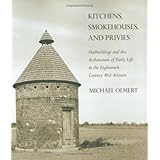
Average Reviews:

(More customer reviews)Author Michael Olmert won his reputation writing Emmy award winning documentaries and scholarly, yet readable, books. Copiously illustrated with almost 100 black and white photographs of survivings outbuildings, Olmert's book gives an excellent overview of the various dependencies which served the large 18th century Tidewater or Chesapeake plantation house - their origins, evolutions, and functions. The book focuses on the kitchens, smokehouses, laundries, dairies, offices, icehouses, and dovecotes of large estates and prosperous plantations with little discussion of the types of outbuildings found on the typical small holders' farms. The book's subtitle, "Outbuildings and the Architecture of Daily Life in the Eighteenth-Century Mid-Atlantic" is misleading. The Mid-Atlantic region includes New York, New Jersey, Pennsylvania, Delaware, and Maryland. However, this book focused almost exclusively on the architecture of the Tidewater Virginia and Chesapeake Virginia and Maryland regions. There were absolutely no photographs of the Eighteenth-Century outbuildings constructed by the English and Dutch Colonists in New York and New Jersey, or by the English,Germanic, and Swiss settlers of Pennsylvania, nor was there anything written about these regions. As a resource for Mid-Atlantic architecture, this book is an enormous disappointment, and is not recommended. Had the book been marketed under a different title, revealing its true content, "Outbuildings and the Architecture of Daily Life in the Eighteenth-Century Tidewater Chesapeake Regions," I would have given it a higher rating. Unfortunately, a greedy publisher, attempting to appeal to a broader audience, chose deception in sub-titling this book. If you are looking for a book on interesting outbuilding of Virginia and Maryland, by all means buy this book. However, if you want a good book on the outbuildings of the Mid-Atlantic Region, this is not the book for you. "Architecture of the Pennsylvania Dutch Country, 1700-1900" by Henry J. Kauffman offers an illustrated and well-annotated introductory overview of the English, German, and Swiss architectural designs found in southeastern Pa. Included are photographs of barns, furniture, smokehouses, icehouses, springhouses, summerhouses, privies, bake ovens, caves, and churches. This book is a better choice for those interested in the outbuildings of the Southestern Pennsylvania region.)Architecture of the Pennsylvania Dutch Country, 1700-1900
Click Here to see more reviews about: Kitchens, Smokehouses, and Privies: Outbuildings and the Architecture of Daily Life in the Eighteenth-Century Mid-Atlantic
In Kitchens, Smokehouses, and Privies, Michael Olmert takes us into the eighteenth-century backyards of colonial America. He explores the many small outbuildings that can still be found at obscure rural farmsteads throughout the Tidewater and greater mid-Atlantic, in towns like Williamsburg and Annapolis, and at elite plantations such as Mount Vernon and Monticello.These structures were designed to support the performance of a single task: cooking food; washing clothes; smoking meat; storing last winter's ice; or keeping milk, cheese, and cream fresh. Privies and small offices are also addressed, as is the dovecote, in which doves were raised for their eggs, squab meat, feathers, and fertilizer. Often, these little buildings were clustered in such a way as to resemble a small village, knit together by similar design details and building materials: they were all constructed in weatherboards or in brick, for instance, or were arranged in a single file or positioned at the four corners of the yard.In this appealing book, featuring nearly a hundred crisp black-and-white photographs, Olmert explains how these well-made buildings actually functioned. He is riveted by the history of outbuildings: their architecture, patterns of use, folklore, and even their literary presence. In two appendixes he also considers octagonal and hexagonal structures, which had special significance, both doctrinal and cultural, in early America.Archaeologists and historians still have many questions about the design and function of outbuildings-questions that are often difficult to answer because of the ephemeral nature of these structures; they were not documented-any more than laundry rooms and storage units inspire rhapsodies today. Olmert's book, deeply grounded in scholarship, eminently readable, and profusely illustrated, takes these buildings seriously and gives them the attention they deserve.

0 comments:
Post a Comment